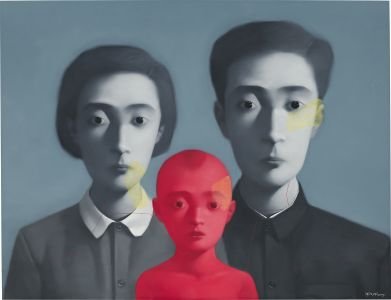We can admire a beautiful painting, acknowledge its technical skill, perhaps even feel a fleeting emotion. Then there are artists who don’t just paint; they excavate the very soul of a nation, extract its history, its traumas, its still-pulsating scars, and thrust them before us like a distorting yet terrifyingly truthful mirror. Zhang Xiaogang is one such artist. He is not merely a commercially successful name in the contemporary art world; he is a visual archaeologist of the Chinese psyche, and his work possesses a haunting resonance that extends far beyond the borders of his homeland.
Born in Kunming, Yunnan Province, China in 1958, Zhang Xiaogang is a leading figure in contemporary Chinese art. He graduated from the Sichuan Academy of Fine Arts in Chongqing in 1982, where he initially trained in the principles of Soviet Realism. However, his artistic interests soon shifted towards Western art movements, particularly Surrealism, which significantly influenced his early work. It was in the 1990s that Zhang developed his signature style, most notably exemplified by his acclaimed ‘Bloodline: The Big Family’ series, which has earned him international recognition.
Forget the vibrant dragons and flamboyant landscapes often associated with Chinese art in the Western imagination. Zhang Xiaogang’s canvases are steeped in a muted palette of grays and blues, the colors of faded memories and long-suppressed emotions. His figures, often arranged in family-like groupings, exude an unsettling stillness, their smooth, almost porcelain faces devoid of overt expression. Yet, it is in this very absence of explicit emotion that the disturbing power of his work lies.

Born in the shadow of the Cultural Revolution, Zhang Xiaogang didn’t just witness history; he lived through an era where individuality was crushed under the weight of collective ideology. This experience is the very DNA of his art. His iconic “Bloodline: The Big Family” series, with its eerily similar faces connected by a thin, often fragile-looking red line, isn’t just a gallery of family portraits. It is a stark commentary on the suffocating nature of collectivism, the erosion of personal identity in the face of societal pressure, and the enduring, often unspoken, bonds that tie generations together, for better or for worse.

Think about those vacant stares. They aren’t empty; they are saturated with the weight of untold histories, of experiences shared in silence, of a generation that learned to mask its true feelings for survival. That red line, the “bloodline,” speaks not only of familial connection but also of the invisible threads of political and social conditioning that run through the fabric of Chinese society. It is a potent symbol of both unity and constraint.

But this is where Zhang Xiaogang’s genius transcends cultural boundaries. Look closer at those seemingly uniform faces. Do they not, in their subtle differences and underlying melancholic beauty, reflect our own struggles with identity and belonging? In a world increasingly obsessed with conformity, with fitting into pre-defined boxes, doesn’t that sense of suppressed individuality resonate with the human experience on a universal level? Are we not all, in some way, connected by invisible “bloodlines” of societal expectations and pressures?

Zhang Xiaogang’s art is not about providing easy answers. It’s about posing difficult questions. It forces us to confront the complexities of history, the fragility of identity, and the delicate balance between the individual and the collective. While his work is deeply rooted in the specific context of China’s past, it serves as a mirror for our own societies, prompting us to consider the ways in which we, too, are shaped by forces beyond our control, and the price we pay for conformity.

Yes, his paintings fetch millions at auction, a testament to his artistic skill and his importance in the art market. But to focus solely on the price tag is to miss the profound message embedded in his canvases. Zhang Xiaogang isn’t just painting pictures; he’s painting the ghosts of a nation’s past, and in doing so, he’s forcing us to confront the ghosts within ourselves. His art is a vital reminder that history, even when seemingly buried, continues to shape our present and our future. It’s a call to look beyond the surface, to question the narratives we are told, and to reflect on the true meaning of individuality in an increasingly interconnected and often homogenizing world. And that, dear readers, is why Zhang Xiaogang isn’t just an important contemporary artist; he is a necessary one.












